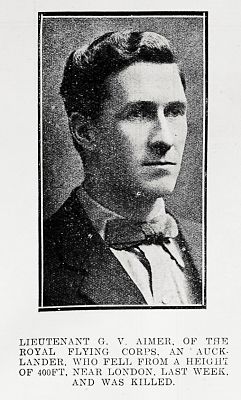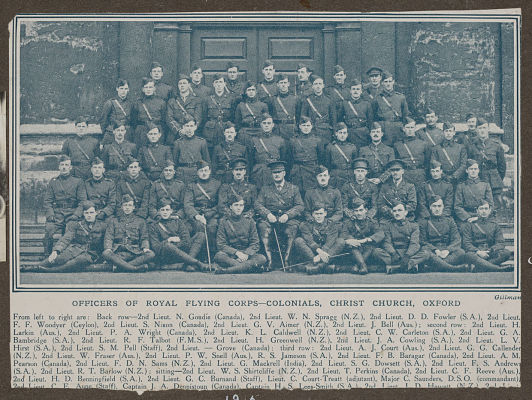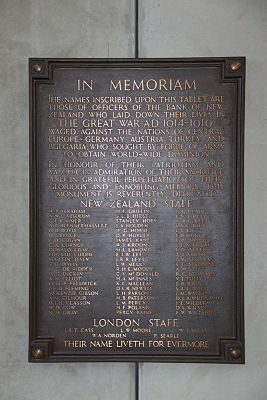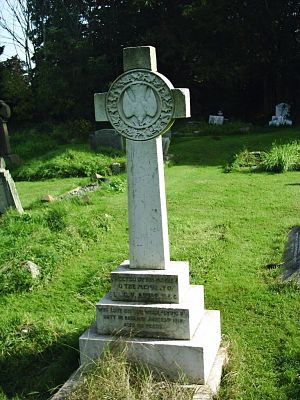WW1 Flight-Lieutenant George Edmond Vernon Aimer RFC
Lieutenant George Vernon Aimer was the eldest son of Edmond Baxter Aimer and Annie Elizabeth Aimer (nee Feek) of Fairburn Road, Otahuhu and Parnell, Auckland. He was born in Whirinaki in the Hokianga in 1886, and was educated at Avondale and Remuera Primary Schools in Auckland.
He was a clerk for Cahill & Co from when he was around 14 years old. At the age of 16, he came into strife when he was found guilty of breaking and entering his employer’s premises in 1903, and stealing £53 17s 2d, for which he served a 12 month sentence. [1] After that low point, however, he was able to make a comeback in his life and career.
For a time he was employed in the Government Forestry Department at Rotorua, subsequently taking a position in Fiji in 1909. [2] Shortly after returning to Auckland in 1910 he entered the service of the Bank of New Zealand. He attended Auckland University College in 1913. [3]. When in Auckland he was very popular in athletic circles, and had at different times, over a period of eight years, been a member of the St. George’s Rowing Club, part of which time he was captain. [4]
In August 1915 he obtained extended leave of absence, and proceeded to England for health reasons. After a short time in hospital he offered his services to the War Office, but they were not accepted, owing to the state of his health. Lieutenant Aimer then studied aviation at the London and Provincial Aviation School as a pilot, and after qualifying for his Royal Aero Club’s pilot’s certificate in February 1916 was appointed an instructor at the London & Provincial Aviation Company’s School. Later he again offered his services to the military authorities, and was given a commission in the Royal Flying Corps in April 1916. He was based at the Royal Flying School at Oxford, 2 School of Instruction as a pilot under training. He joined the 4 Reserve Squadron on 17 May 1916 and the 11 Reserve Squadron on 21 May 1916. He earned his pilot’s badge on 17 June 1916. [5] [6]
While flying on solo training from an aerodrome in Middlesex, north of London, most likely with 4 or 11 Reserve Squadron based at Northolt, on the 20th June 1916 , Aimer’s plane, a Martinsyde S1 696, fell into a spin at about 3000 feet and dived into the ground. [6] George Aimer died later in the day at RFC Hospital in Bryanston Square, London. At the inquest on Flight Lieutenant Aimer, the evidence showed that the deceased’s machine suddenly swerved, wobbled, and then crashed vertically to earth. A verdict of accidental death was returned. He was 30 years old. [7] His brother Kenneth Aimer also served during the war went on to become a well-known architect, and part of the partnership of Grierson, Aimer and Draffin who designed the Auckland War Memorial Museum in the 1920s. A brother, Trooper Alexander Goven Aimer, left for the front with the 13th Reinforcements. [8]
George’s name is included on both the Avondale and Remuera School war memorials.
George Aimer is buried in the Ruislip (St Martin) Churchyard Extension, Middlesex, England and is memorialised on the Bank of New Zealand plaque in Wellington: ‘In Memoriam: The names inscribed upon this tablet are those of officers of the Bank of New Zealand who laid down their lives in the Great War AD 1914-1919 waged against the nations of central Europe – Germany, Austria, Turkey and Bulgaria – who sought by force of arms to obtain world-wide dominion. In honour of their patriotism and valour. In admiration of their sacrifice. And in grateful perpetuation of their glorious and ennobling memory this monument is reverently dedicated. Their Name Liveth for Evermore.’
ON ACTIVE SERVICE. FOR KING AND COUNTRY. —On June 20, through a fall from an aeroplane. Lieut. George Edmond Vernon Aimer, of R.F.C., eldest son of Mr and Mrs E. B. Aimer, St. Stephen’s Avenue, Parnell. Interred at Ruislip, Middlesex, England. [8]




